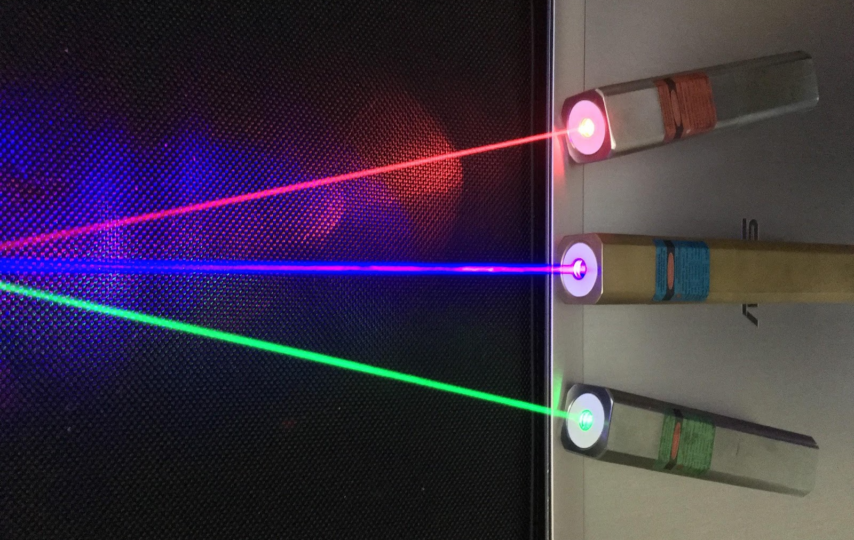Enter the fascinating world of laser pointers and get ready to learn how these amazing tools operate. Have you ever wondered how these little but powerful portable devices create their amazing light beams? Join us as we explore the complex physics underlying laser pointers operating in a fun and interactive adventure. We shall solve the puzzles and reveal the secrets that allow laser pointers to mesmerize us with their brilliant light. From the fascinating phenomenon of stimulated emission to the complex procedure of optical amplification. So be ready for an educational journey as we illuminate the interesting fact about “how does a laser pointer work?”.
What is a Laser Pointer?
A laser pointer is a small, portable device that generates a laser-generated beam of light that is focused and concentrated. Its main purpose during presentations, seminars, or demonstrations is to draw attention to certain items or areas of interest. Red is the most common color for laser pointers, which exist in other colors as well. They are portable and simple to use; to start the laser beam, a button is often pressed. It is crucial to use laser pointers responsibly and safely. Making sure they are not pointed towards people’s eyes, airplanes, or other delicate objects.
How does a Laser Pointer work?
Laser pointers play an important part in our daily life applications which we won’t recognize. But, we clearly observe the laser beams while playing with laser toys. But do you know “how does a laser pointer work?”. Here’s a detailed explanation of how laser pointer works :

Image credit – socratic
Working of Laser Pointers :
Utilizing the concepts of stimulated emission and optical amplification, a laser pointer works. A laser diode, a power source (usually batteries), and optics for beam focussing and manipulation make up its basic parts.
A semiconductor material is sandwiched between layers of other materials in a laser diode. When a voltage is supplied, this setup creates a diode junction, which is triggered to allow current to flow.
The semiconductor’s atoms are stimulated when current passes across the diode junction, raising the electrons’ energy levels. The electrons become very energetically stable and go into a condition known as “metastable.”
The semiconductor material is contained within a tiny cavity that serves as an optical resonator. Two mirrors are housed in this hollow, one of which is entirely reflecting and the other is just half reflective. While a partly reflecting mirror allows some light to escape as the laser beam. A completely reflective mirror makes it easier for light to reflect.
The metastable electrons release energy in the form of photons when they return to their lower energy state. These photons bounce off of the mirrors, inspiring other excited electrons to go through related transitions. Stimulated emission, which is a phenomenon, starts a chain reaction that ends with the emission of a coherent. Monochromatic laser beam through the partially reflecting mirror.
The output laser beam is concentrated into a narrowly focused stream of light using optics, such as lenses or prisms. The unique characteristics of the semiconductor material employed in the diode define the color of the laser beam. For instance, semiconductor materials that generate light in the red spectrum are often used in red laser pointers.
It is crucial to utilize laser pointers responsibly and safely. If directed at someone’s eyes or utilized improperly, the focused beam of light might be dangerous. As a result, it is essential to follow the rules and prevent aiming the laser pointer. Towards people, vehicles, or other delicate objects.
Types of Laser Pointers
There are several kinds of laser pointers, each with a unique output power, wavelength, and intended uses. Several types of laser pointers are listed below:
1. Red laser pointers

Image credit – amazon.in
The most well-known and often used kind, red laser pointers generate a beam with a typical wavelength. That ranges 650 to 660 nanometers. They are often used in astronomy, presentations, and other pointing duties.
2. Green laser pointers

Image credit – amazon.in
These devices produce a green beam at a wavelength of around 532 nm. They are distinguished from their red counterparts by their improved visibility and brightness. They are popular for stargazing, outdoor pursuits, and in certain workplaces.
3. Blue/Violet laser pointing apparatus

Image credit – digital connect mag
Blue and violet laser pointing apparatuses generate shorter wavelengths, usually between 405 and 450 nm. The ensuing blue or violet lasers provide aesthetically stunning effects. They are useful in a variety of situations, including scientific, educational, and industrial ones.
4. laser pointers with many colors

Image credit – dpss laser diode
Some laser pointers allow users to flip between colors. Users of these adaptable pointers may project beams in many colors. Including red, green, and blue, by using replaceable diodes or filters.
5. High-powered laser pointers

Image credit – amazon.in
Also referred to as “burning lasers” or “laser torches,” high-powered laser pointers have much higher output powers than conventional pointers. They produce powerful beams that are used in science, entertainment, and industry. When using high-powered lasers, vigilance is essential due to their possible risks.
6. Presentation of laser pointers

Image credit – amazon.in
Designed specifically for lectures, meetings, and presentations, these pointers include extra features. Like wireless connectivity, built-in controls for slideshows, and remote control capabilities. To make it easier to navigate presentation materials.
It is essential to remember that law and permitted power restrictions for laser pointers differ across nations. Adherence to regional laws, regulations, and safety precautions is necessary for the responsible and secure use of laser pointers.
Where do Laser pointers are Used?
Laser pointing systems are used in many different industries. Here are a few applications for laser pointers:
1. Presentations and talks
Laser pointers are often used in presentations and speeches to highlight crucial information, direct the audience’s attention. Which makes it easier to navigate visual aids. They increase engagement and provide speakers with a clear, visual signal.
2. Astronomy and stargazing
Laser pointing tools with improved visibility, including green lasers, help astronomers identify celestial objects or constellations. They assist astronomers, amateurs, and educators in emphasizing certain stars, planets, or celestial objects.
3. Education and Teaching
Laser pointers are used by teachers to draw attention to specific details in diagrams, equations. Or text that is projected onto whiteboards or other educational displays in classrooms and other settings. laser pointing systems improve visibility and facilitate efficient information transfer.
4. Construction and Alignment
Laser pointers are used in engineering and construction for precise alignment and leveling tasks. They aid in precisely aligning walls, fixtures, and other features. Laser levels, which combine leveling tools and laser pointers, are often used in these situations.
5. Interactive cat toys
Laser pointers are a preferred kind of interactive cat toy. The laser pointer’s elusive red dot stimulates a cat’s natural hunting instincts, giving it exercise and entertainment. To avoid any possible danger, it is essential to make sure the laser beam is not pointed towards the cat’s eyes.
6. Entertainment and laser shows
To create visually stunning effects, powerful laser pointers are used in entertainment venues such as laser light displays and concerts. These lasers show complex designs, animations, and beams that match the beat of music, giving concerts a dynamic visual component.
7. Applications in Industry and Science
Laser pointers have a wide range of uses in industry and academia. In industrial contexts, they may be used for equipment alignment, positioning, and calibration. Laser pointing tools are also used for measurements, experimentation, and research in the domains of physics, biology, and optics.
It’s critical to utilize laser pointers responsibly and safely while according to regional regulations. It is important to take precautions to prevent shining laser beams directly into people’s eyes. Also shooting lasers at planes, and utilizing powerful lasers without the proper training and experience.
Do’s & Don’ts of Laser pointers
The following are crucial advice and security precautions to take into account while using laser pointers:
Do’s:
1. Use laser pointers solely for the uses they were designed for, such as presentations or instructional software.
2. Comply with local rules and regulations controlling the use of laser pointers. Especially those pertaining to power limitations.
3. Keep laser pointers out of children’s and others’ reach who could abuse them.
4. Pay attention to the laser pointer’s power output and any possible dangers.
5. To avoid accidental eye exposure, direct the laser beam away from individuals, particularly their eyes.
6. Use care to avoid aiming laser pointers toward objects that can reflect the beam. Which might cause it to come back at you or other people.
7. Keep laser pointers secure in protective cases or take the necessary precautions to avoid accidental activation.
Don’ts:
1. Never direct laser pointers toward people, animals, cars, or airplanes. This may seriously damage eyes or cause pilots to get distracted.
2. Avoid using laser pointers carelessly or in a disruptive way that can endanger, annoy, or upset others.
3. Refrain from utilizing high-powered laser pointing equipment if you don’t have the necessary skills, information, or understanding of the risks involved.
4. laser pointers should not be altered or tampered with in order to enhance their power output. As this might result in dangerous and unpredictable behavior.
5. Avoid classifying laser-pointing gadgets as toys or letting kids use them unattended.
6. Refrain from utilizing laser pointers in circumstances where the beam can impair others’ visibility or safety.
7. Avoid flashing laser pointers toward security systems, optical sensors, or other delicate equipment.
You may assure the responsible and safe use of laser pointers. While lowering your risk of mishaps or hurting yourself or others by following these instructions.
Conclusion
We have learned a lot about “how does a laser pointer work?”. As we conclude our investigation into this intriguing field. We have solved the mystery of how these portable wonders produce their strength. Also accurate beams of light by exploring ideas such as stimulated emission and optical amplification. No matter whether they are used for presentations, astronomy, or amusement, laser pointers continue to enthrall us with many uses. Let’s take a moment to appreciate the complex science and technology that underlies laser pointer functioning. As we come to the end of this illuminating trip. Never forget that using them responsibly and safely guarantees that their brilliance enhances our experiences without jeopardizing safety.








